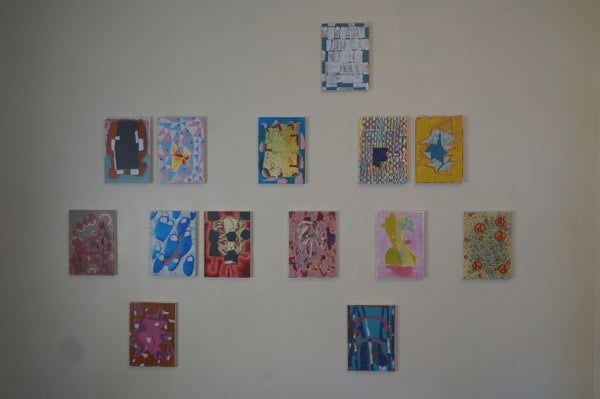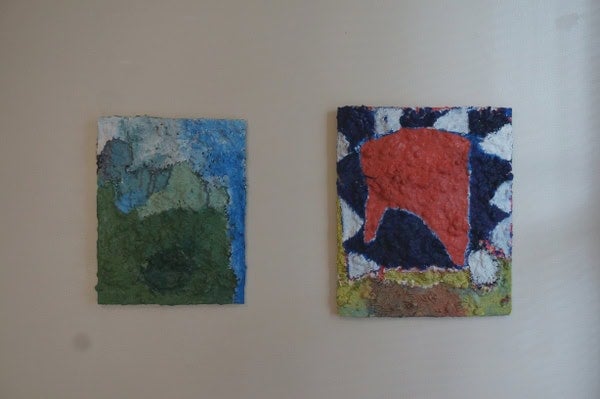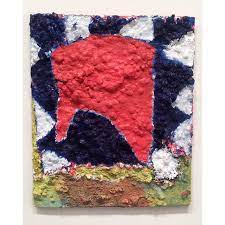
“Old Man Study Group,” at Southfork gallery in Memphis through July 4, features collaborative paintings by Hamlett Dobbins and Douglas Degges. Southfork is located in the home of Lauren Kennedy. It’s one of a handful of home galleries in Memphis, built on hospitality and the belief that art should not live exclusively in sacred spaces that require literal or figurative membership.
Hamlett Dobbins was born in Knoxville and raised on a family farm in Memphis. On his website, he lays out a chronology of his development that begins in 1528 with Iacopo Pontormo’s The Deposition from the Cross for Santa Felicita and charts events, births, and deaths that have influenced him artistically and personally. He holds an MA (1998) and an MFA (1999) from the University of Iowa. Douglas Degges was born in Shreveport, and ,attended Rhodes College in Memphis, where Dobbins was his teacher. Degges also holds an MA (2011) and an MFA (2012) from the University of Iowa. He lives and works in Queens, New York.
Two solo works by each artist are included in the show. Degges’s two pieces are good examples of his oeuvre. He builds up oil paint and gypsum inches thick in bold 3D mounds that suggest erosion even as they insist outwards. Dobbins’s two paintings, from his series “MMY Drawings,” are contemplative abstractions in Easter egg pastels.
The collaborative acrylic on panel paintings in “Old Man Study Group” do not so much suggest a blending of these two styles but the creation of a new one that’s filled with light and suggestive imagery that doesn’t solidify into form. Degges and Dobbins choose from a palette of cerulean blues, bubblegum pinks, and maizey yellows that call and answer to each other across the room. I spoke to the artists about their collaboration.
Erica Ciccarone: You both have a history of collaborating with other artists. What draws you to artistic collaborations?
Douglas Degges: I love collaborating with Hamlett for very particular reasons. In general, I like collaborating because I can pretend to be another person and make decisions, moves, material choices, or material handling decisions that I wouldn’t normally make. I find myself taking risks, and it doesn’t actually feel like that’s what I’m doing. All that other great stuff is built into it as well: sharing ownership, deciding if something is finished, thinking about authorship. With Hamlett, it feels like a conversation that happens really slowly.
Hamlett Dobbins: Sometimes I teach collaboration as a model for working, and for me it’s such a great way to have a visual conversation. So much of my brain exists as a pretty verbal space where I’m assigning words to thoughts. For me to be able to have a kind of visual conversation with someone helps me in my studio practice and in making me feel like a social person: to be in that space where I’m following their clues and listening to what they’re doing and seeing what they’re doing and then responding to it.
Also, as Douglas said, it’s really great to do things that you normally wouldn’t do in your own studio practice. The great thing about collaborating is that I’m able to play with other people’s toys. It’s a conversation. If I’m in my studio and I’m talking to myself, I know I’m going to talk about barbeque and what I heard on Fresh Air that week, maybe a couple other things but that’s mostly going to be it. When drawing with someone else, we get to a place of “How did we get on this subject? How did we get way over here?” It’s like a conversation that ends in all the best ways.
It’s also a thing that I do to stay in touch with people through long distances. There are some people that I collaborated with that live in Brooklyn and some people in Memphis and Minneapolis and lots of other places, so there’s this back and forth, and inevitably a surprise happens. Douglas talked about lack of ownership, it’s such a great thing.
EC: What’s your process like together?

DD: Initially, the plan was to mail a notebook back and forth, each starting with his own piece. Hamlett made a bunch of panels that we mailed back and forth for a while. Now we see each other often enough that we can hang out in real time and make the stuff together. That’s what it’s become now. Sitting across from each other at the table, making work that way.
HD: It’s totally different from person to person, and depending on my blood sugar, and everything else. Some days when I collaborate with people, I’m the finisher. I’m just the one who sits down like, “How am I gonna fix this? How am I gonna finish this? How am I gonna pull all these parts together?” It’s a part of my brain that I never use in my own work. On my own, everything’s pretty straightforward and follows a very particular path that’s set up early on in my process.
Sometimes when I collaborate with people, I’m the starter. I start a riff or make a mess and pass it to someone, and that person messes with it some more and they fix it, and then it’s totally done. That’s also a great thing about collaborating; if I call something done, something particular has to happen. I have a little internal checklist. When Douglas says something’s done, he has his own internal checklist. In this last show, there were these two paintings, maybe just one, where I just kept grabbing the painting like, “I’m gonna work on this. I’m gonna figure this out.” At some point I was like, “Just leave it. I’m okay with it.”
EC: I imagine that it’s a bit like improv comedy. If your partner says, “What are you doing with that gun?,” you have to produce a gun.
HD: Exactly. A lot of it, too, is just about respect. Very rarely at the end do I say, “I didn’t touch that at all. That’s all you.” Inevitably, there’s some part of each of us that’s left. Douglas and I both have a shared sensibility in terms of knowing when to cover stuff up. I’ve collaborated with people before in bars or wherever, and I’ll pass them something that I’ve worked really hard on and then their collaboration is to cover it with white paint. Probably not the most respectful thing to do. You’re able to pick your buddies at that point.

EC: How do you know when a piece is done?
HD: I always just pin it on Joan Mitchell. She said it’s done when it stops bugging her. If I turn around and look at it and I’m like, “Sweet,” then it’s done. If it still bugs me or irritates me, either it’s not done or I am not in a place in my life where I can accept it as being done. Sometimes things get set to the side and then a month or two later I can come back and be like, “You know, that’s really good.” I like that. Douglas, how do you know?
DD: I know in the same way. The one little caveat is that it only takes one of us to say something’s finished and then the other person most of the time has to live with that. There are a few exceptions. That’s kind of fun and a particularly interesting part of discerning finish. There are a few paintings in “Old Man Study Group” that one of us was a lot more enthused with than the other.
And that’s kind of fun too, for the same reason that Hamlett is saying. Later, somehow our tastes and our interests or whatever memory that particular painting holds, no matter how ugly or uncomfortable I am in front of it, it recalls all this other stuff. Later, the paintings that I don’t like that Hamlett called done, I find myself liking for a number of reasons. That’s pretty great because of what it asks for me in terms of taste. My taste is always unfolding and changing. Generally, it’s more open, so the collaboration helps expedite that whole process. It demands that my taste be more open than it usually is.
EC: How long have you been collaborating?
DD: Since 2009, Hamlett?
HD: Yeah, is that when you graduated?
DD: Yeah. So Hamlett was my teacher. As soon as I graduated, we started making these things.
HD: I taught collaborative drawing and painting classes at Rhodes College. Douglas was in my class his senior year, and then he graduated. I always work in these Holbein notebooks that I like a lot. They’re durable good notebooks, and I gave him one. He went to graduate school in Iowa, which is how I knew about collaborating. When I was in undergrad, I took some paintings to this gallery here in town. I was coming out the gallery with my paintings under my arm, and these guys walked by who I kind of knew. They said, “Hamlett, I really like your paintings. Have you ever thought of collaborating with someone else?” I thought to myself, “God, why would I ever take something that I put my heart and soul into and then hand it over to you to fuck up. Why would I ever do that?”
I went to Iowa and met David Dunlap, who taught both of us. At the time, I was making art about microphones that Dr. King used in his speeches. David made art about Dr. King, and his story started folding into mine. We just hung out and made drawings listening to Dr. King’s speeches on audiotape. Really, it was just a chance for me to be around David and see how he works and talk with him a little bit. I didn’t expect it turn into anything. It’s just such a wonderful way to have a kind of parallel conversation.
Douglas and I get together and sit across from each other and talk about old friends, we talk about David, we talk about Iowa and other painters. That’s our conversation. The whole time we’re doing that, we’re having a visual conversation at the same time. Very rarely do we say, “Oh this needs so-and-so.”
EC: Douglas, do you find that to be the same in your other collaborations, or do you have more conversation about the work as you go?
DD: The other collaboration I’m actively involved in at the moment happens pretty similarly. I was in a trio in grad school at Iowa that happened a bit differently. There were a number of constraints, most of them were size and material, and the personalities at work in that one required more of that stuff than it does with Hamlett or my buddy Eric [Oglander].
HD: It’s interesting when you talk about who you collaborate with. Do you ever listen to Dan Savage?
EC: Yeah. Modern Love.
HD: He talks about how you go to a bar and flirt with other people, and then you come home and put all that energy into the relationship that you’re in. I’m not saying that’s the way it is with Douglas or my other collaborators, but when I collaborate with other people, it gets my juices going, and then I can’t wait to get in the studio myself. I know some people who have practices or side projects that are draining, but to me this is like a super charger. I get all of these great ideas and things to riff off and try on my own or to manipulate or bend or in some way incorporate into some other thing. It’s so much fun.
EC: Are there other works in “Old Man Study Group” that did not make it into the show? Did Lauren Kennedy help you edit?
DD: Lauren wasn’t really involved in deciding how the work went up outside of inviting us to do the show, which was really nice. I brought a bunch of panels with me on the plane and showed up early — on a Sunday and the show was opening on a Friday — and we did nothing but make paintings together. We showed the ones we finished.
EC: So these were all made in that week? You had a marathon together.
HD: One of the nice things about collaborating is that my two kids hang out with us, so they get to know my artist friends. We hang out and sit around the table and make these drawings. A lot of times, when you get kids in a room with adults, they’re kind of like, “How can I get out of here?” They worry about awkward silence. Collaborating lets you sit at a table and draw, and if you think of something you can say something like, “Hey, do you like ‘Adventure Time’?” And these conversations unfold without any kind of pressure.
Several moves that were in those paintings came from drawings we made with my son. My son has drawings that he made with Douglas in his stash and Douglas has drawings that he made with my son. I have this big file at my house that’s full of drawings that we made either as a family or that we’ve made as a family plus some visiting artist. We used to have an exhibition space in the place where we live. We’d have artists stay with us and we’d have shows downstairs.
EC: I love the home galleries in Memphis. I went to Southfork and to Glitch, and I would love something like that in Nashville. I think it’s so cool, and it matched the general hospitality of people in Memphis.
HD: That word “hospitality” is the way that Lauren sees it. My space was different in that I had an old storefront. In the back of the storefront was my studio and the front was the gallery. We lived upstairs. It wasn’t so much about the mixing of home and exhibition space; Lauren’s space (Southfork) and then Glitch and another space called Beige run by Joel Parsons all grew out of a very Chicago idea of not being satisfied with what happens at commercial galleries or museums. People step up and do their own thing. When Joe moved back to Memphis from Chicago, he felt like there weren’t enough shows about core issues or key, so he opened Beige.
Lauren’s idea with Southfork is maybe a little less specific in terms of the artists that she shows. She had been in Dallas for a long time. Part of it is giving people an opportunity to show their work. It’s really easy and it’s cheap. It’s not like you have to kill yourself to do it.
EC: Are there any home galleries in New York, Douglas?
DD: Yeah, a ton of people have apartment galleries, and most of the time they’re pop-up spaces. They’re not all the time given over to a gallery, and that might have something to do with everyone having a smaller footprint and space being super expensive. There are a lot of music spaces in people’s homes in Bushwick, and some of those spaces have art openings paired with performances. It’s similar to what Lauren is doing.




